曼昆.经济学19-21
- 格式:ppt
- 大小:1.05 MB
- 文档页数:110
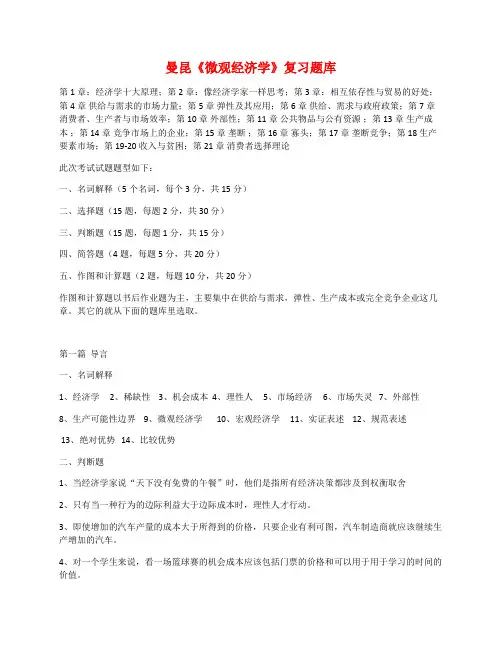
曼昆《微观经济学》复习题库第1章:经济学十大原理;第2章:像经济学家一样思考;第3章:相互依存性与贸易的好处;第4章供给与需求的市场力量;第5章弹性及其应用;第6章供给、需求与政府政策;第7章消费者、生产者与市场效率;第10章外部性;第11章公共物品与公有资源;第13章生产成本;第14章竞争市场上的企业;第15章垄断;第16章寡头;第17章垄断竞争;第18 生产要素市场;第19-20收入与贫困;第21章消费者选择理论此次考试试题题型如下:一、名词解释(5个名词,每个3分,共15分)二、选择题(15题,每题2分,共30分)三、判断题(15题,每题1分,共15分)四、简答题(4题,每题5分,共20分)五、作图和计算题(2题,每题10分,共20分)作图和计算题以书后作业题为主,主要集中在供给与需求,弹性、生产成本或完全竞争企业这几章。
其它的就从下面的题库里选取。
第一篇导言一、名词解释1、经济学2、稀缺性3、机会成本4、理性人5、市场经济6、市场失灵7、外部性8、生产可能性边界 9、微观经济学 10、宏观经济学 11、实证表述 12、规范表述13、绝对优势 14、比较优势二、判断题1、当经济学家说“天下没有免费的午餐”时,他们是指所有经济决策都涉及到权衡取舍2、只有当一种行为的边际利益大于边际成本时,理性人才行动。
3、即使增加的汽车产量的成本大于所得到的价格,只要企业有利可图,汽车制造商就应该继续生产增加的汽车。
4、对一个学生来说,看一场篮球赛的机会成本应该包括门票的价格和可以用于用于学习的时间的价值。
5、当一架喷气式飞机从头上飞过时,噪音引起外部性6、李文更擅长打扫卫生,姜飞更擅长做饭。
如果姜飞专门做饭而李文专门打扫卫生,这将比他们平等地分摊家务所需要的时间少。
7、一个农民在小麦市场上更可能有市场势力。
8、美国工人有较高的生活水平是因为美国有较高的最低工资9、在短期中,降低通货膨胀往往会引起失业减少。
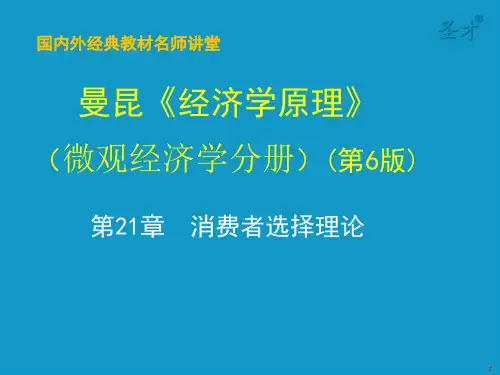
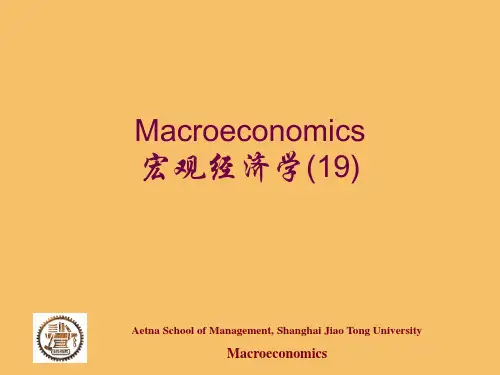
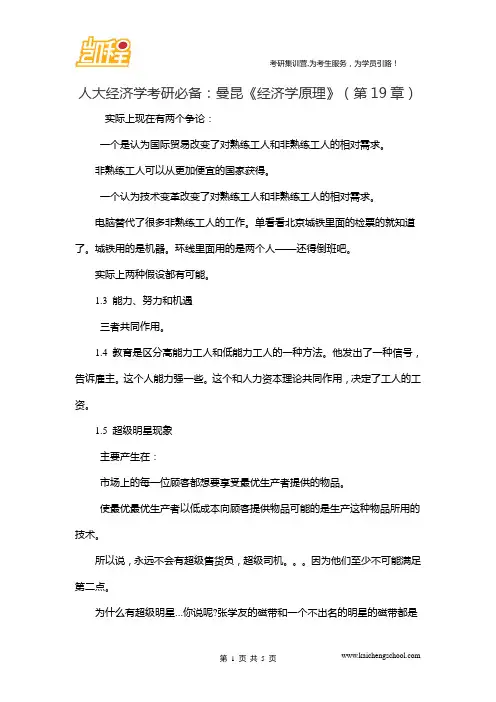
人大经济学考研必备:曼昆《经济学原理》(第19章)实际上现在有两个争论:一个是认为国际贸易改变了对熟练工人和非熟练工人的相对需求。
非熟练工人可以从更加便宜的国家获得。
一个认为技术变革改变了对熟练工人和非熟练工人的相对需求。
电脑替代了很多非熟练工人的工作。
单看看北京城铁里面的检票的就知道了。
城铁用的是机器。
环线里面用的是两个人——还得倒班吧。
实际上两种假设都有可能。
1.3 能力、努力和机遇三者共同作用。
1.4 教育是区分高能力工人和低能力工人的一种方法。
他发出了一种信号,告诉雇主。
这个人能力强一些。
这个和人力资本理论共同作用,决定了工人的工资。
1.5 超级明星现象主要产生在:市场上的每一位顾客都想要享受最优生产者提供的物品。
使最优最优生产者以低成本向顾客提供物品可能的是生产这种物品所用的技术。
所以说,永远不会有超级售货员,超级司机。
因为他们至少不可能满足第二点。
为什么有超级明星…你说呢?张学友的磁带和一个不出名的明星的磁带都是10块,你买哪一块?因为第一点不同。
1.6 高于均衡工资:最低工资法、工会和效率工资这个概念是什么意思呢?就是说对于某些工人而言,他们的工资会比供求平衡的水平高!第一个原因是:最低工资法。
政府规定了最低工资。
第二个原因是:工会的市场势力。
还记得几年前的NBA劳资纠纷么。
这就是工会和老板(企业)之间的一个博弈。
有了工会,工资会高10%~20%。
第三个原因:效率工资。
企业会发现高工资是有利的。
由此,他会保持较高的工资来增加工人的劳动效率,减少工人的流动性。
第二节歧视经济学收入当中的差别是基于种族、性别或者其他的因素的歧视。
实际上歧视的衡量很困难。
人们应该根据人力资本和工作特性的差别进行校正。
竞争市场倾向于限制歧视对工资的影响。
如果一个工人群体的工资由于边际生产率无关的原因而低于另一个工人群体,那么,非歧视企业将比歧视企业盈利更多。
(雇主的歧视行为的反映)。
利润的最大化行为将减少歧视性工资差别。
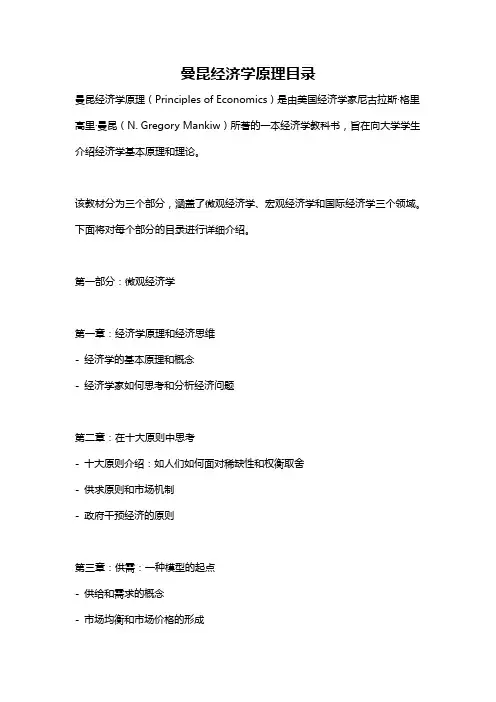
曼昆经济学原理目录曼昆经济学原理(Principles of Economics)是由美国经济学家尼古拉斯·格里高里·曼昆(N. Gregory Mankiw)所著的一本经济学教科书,旨在向大学学生介绍经济学基本原理和理论。
该教材分为三个部分,涵盖了微观经济学、宏观经济学和国际经济学三个领域。
下面将对每个部分的目录进行详细介绍。
第一部分:微观经济学第一章:经济学原理和经济思维- 经济学的基本原理和概念- 经济学家如何思考和分析经济问题第二章:在十大原则中思考- 十大原则介绍:如人们如何面对稀缺性和权衡取舍- 供求原则和市场机制- 政府干预经济的原则第三章:供需:一种模型的起点- 供给和需求的概念- 市场均衡和市场价格的形成- 自由市场与政府管制的比较第四章:市场效果:量与质的考虑- 市场效率和福利经济学- 市场失灵和外部性- 公共物品和共享资源第五章:务实的消费者和无穷的厂商- 消费者选择行为和效用最大化- 企业产量选择和生产成本- 供给曲线和市场调整第六章:市场均衡和资源配置- 市场均衡的概念和效率性- 供求关系和经济的资源配置- 政府政策和市场效率的影响第二部分:宏观经济学第七章:储蓄、投资和资本市场- 储蓄、投资和财务体系- 成本效益分析和资本市场的理论第八章:经济增长和生产函数- 国民收入和生产函数的概念- 技术进步和经济增长- 资本积累对经济增长的影响第九章:失业和通货膨胀- 失业和就业水平- 失业的成因和传统观点- 通货膨胀和货币政策第十章:货币和银行体系- 货币和货币供给- 银行体系和货币创造- 中央银行政策和货币政策工具第十一章:货币市场和货币政策- 资本市场和货币市场的联系- 货币市场利率和货币政策的影响- 货币供给和货币创造的影响第三部分:国际经济学第十二章:国际贸易的原理和比较优势- 国际贸易的原理和概念- 绝对优势和比较优势- 贸易制度和贸易政策第十三章:国际贸易的应用和政策- 暂定均衡和相对比较优势- 贸易政策和进出口管制- 贸易摩擦和贸易战争第十四章:国际金融与公共金融- 汇率和外汇市场- 货币政策和国际金融体系- 公共债务和国际金融危机曼昆经济学原理目录总共包括了14个章节,它们涵盖了经济学的基本原理和概念,并且深入探讨了微观经济学、宏观经济学和国际经济学的各个领域。

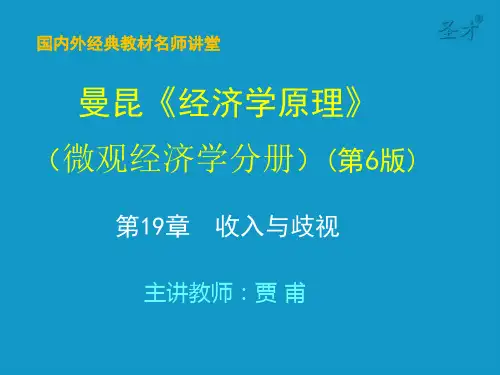
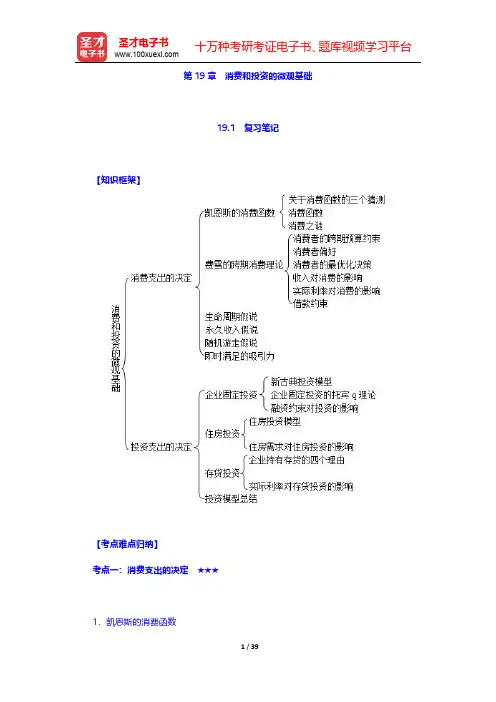
第19章消费和投资的微观基础19.1复习笔记【知识框架】【考点难点归纳】考点一:消费支出的决定★★★1.凯恩斯的消费函数(1)凯恩斯关于消费函数的三个猜测①边际消费倾向在0~1之间。
②平均消费倾向随着收入的增加而下降。
③收入是决定消费的主要因素,利率对消费的影响不大。
(2)消费函数凯恩斯消费函数通常表示为:C=_C+cY。
式中,_C>0,是固定水平的“主动消费”;Y 是可支配收入;c是边际消费倾向,0<c<1。
如图19-1所示,边际消费倾向MPC是消费函数的斜率,由平均消费倾向APC=C/Y=_C/Y+c,当Y增加时,_C/Y下降,从而平均消费倾向下降。
图19-1凯恩斯消费函数(3)消费之谜早期的基于家庭短期时间序列数据、两次世界大战之间消费与收入的总量数据的研究都验证了凯恩斯消费函数边际消费倾向和平均消费倾向的猜测。
但二战后的长期时间序列数据表明,凯恩斯关于平均消费倾向随收入的增加而下降的猜测与现实经济运行情况并不吻合,长期平均消费倾向是稳定的。
也就是说,短期消费函数和长期消费函数是不一样的,这就是“消费之谜”。
平均消费倾向在短期内是下降的,但在长期内是不变的。
因此,凯恩斯消费函数类似于短期消费函数。
2.费雪的跨期消费理论(1)消费者的跨期预算约束假设消费者既可以储蓄又可以借贷,且不存在借贷制约。
跨期预算约束是指人们的消费取决于可用于现在和未来消费的总资源,即:C1+C2/(1+r)=Y1+Y2/(1+r),如图19-2所示。
图19-2消费者的预算约束(2)消费者偏好无差异曲线表示能给消费者带来相同效用水平的两个时期的各种消费组合点的轨迹,斜率等于第一期消费和第二期消费的边际替代率。
如图19-3所示,IC1和IC2是代表不同效用水平的无差异曲线。
点Y、点X和点W的消费者效用水平相等,且都低于点Z的效用水平。
图19-3消费者偏好(3)消费者的最优化决策消费者通过选择预算线上可接触到最高无差异曲线的一点,达到最高水平的满足。
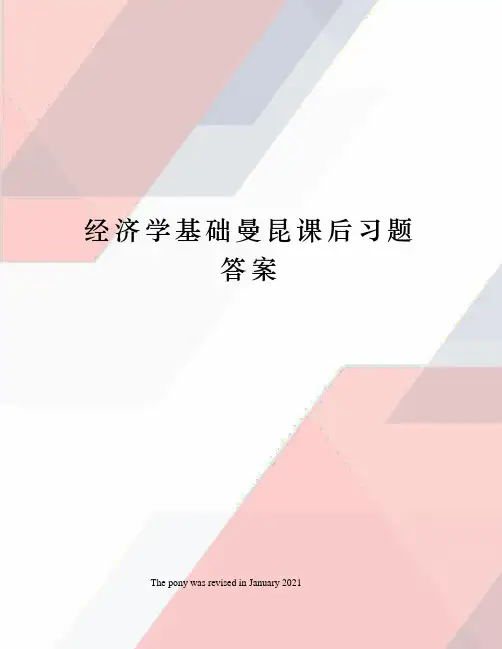
经济学基础曼昆课后习题答案The pony was revised in January 2021第一章经济学十大原理一、为每个关键术语选择一个定义关键术语定义--------------稀缺性 1、在社会成员中平等地分配利益的特征--------------经济学 2、市场不能有效的配置资源的状况--------------效率 3、有限的资源和无限的欲望--------------平等 4、一个工人一小时所生产的物品与劳务量--------------理性 5、市场上只有一个买者的情况--------------机会成本 6、利己的市场参与者可以不知不觉的使整体社会福利最大化的原理--------------边际变动 7、社会从其稀缺资源中得到最多东西的特性--------------激励 8、社会和企业在市场上的相互交易决定资源配置的经济--------------市场经济 9、经济活动的波动--------------产权 10、当一个人的行为对旁观者有影响时的情况--------------“看不见的手” 11、物价总水平的上升--------------市场失灵 12、对现行计划的增量调整--------------外部性 13、研究社会如何管理其稀缺资源--------------市场势力 14、得到某种东西所放弃的东西--------------垄断 15、一个人或一群人不适当的影响市场价格的能力--------------生产率 16、某种引起人行动的东西--------------通货膨胀 17、一个人拥有并使用稀缺资源的能力--------------经济周期 18、为了达到目标而尽可能系统性的做到最好二、判断正误--------------1、当政府用税收和福利再分配收入时,经济变得更有效率。
-------------2、当经济学家说“天下没有免费的午餐”时,他们是指所有经济决策都涉及权衡取舍。
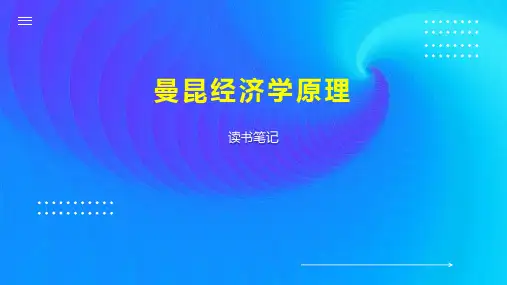
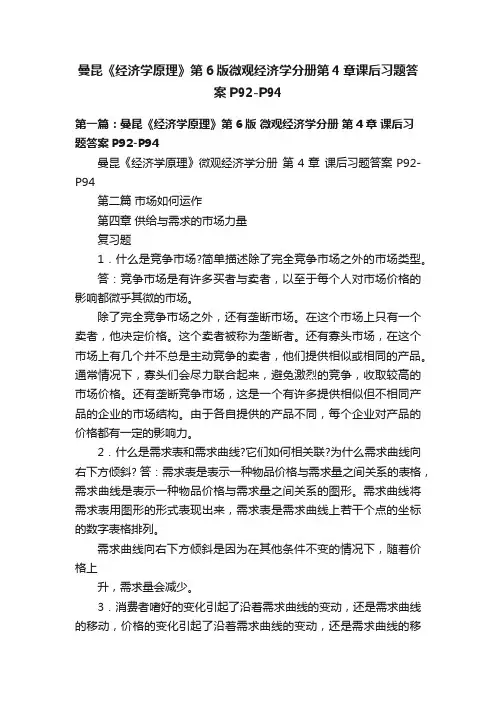
曼昆《经济学原理》第6版微观经济学分册第4章课后习题答案P92-P94第一篇:曼昆《经济学原理》第6版微观经济学分册第4章课后习题答案P92-P94曼昆《经济学原理》微观经济学分册第4章课后习题答案P92-P94第二篇市场如何运作第四章供给与需求的市场力量复习题1.什么是竞争市场?简单描述除了完全竞争市场之外的市场类型。
答:竞争市场是有许多买者与卖者,以至于每个人对市场价格的影响都微乎其微的市场。
除了完全竞争市场之外,还有垄断市场。
在这个市场上只有一个卖者,他决定价格。
这个卖者被称为垄断者。
还有寡头市场,在这个市场上有几个并不总是主动竞争的卖者,他们提供相似或相同的产品。
通常情况下,寡头们会尽力联合起来,避免激烈的竞争,收取较高的市场价格。
还有垄断竞争市场,这是一个有许多提供相似但不相同产品的企业的市场结构。
由于各自提供的产品不同,每个企业对产品的价格都有一定的影响力。
2.什么是需求表和需求曲线?它们如何相关联?为什么需求曲线向右下方倾斜? 答:需求表是表示一种物品价格与需求量之间关系的表格,需求曲线是表示一种物品价格与需求量之间关系的图形。
需求曲线将需求表用图形的形式表现出来,需求表是需求曲线上若干个点的坐标的数字表格排列。
需求曲线向右下方倾斜是因为在其他条件不变的情况下,随着价格上升,需求量会减少。
3.消费者嗜好的变化引起了沿着需求曲线的变动,还是需求曲线的移动,价格的变化引起了沿着需求曲线的变动,还是需求曲线的移动? 答:消费者嗜好的变化引起了需求曲线的移动,价格的变化引起了沿着需求曲线的变动。
4.Popeye的收入减少了,结果他买了更多的菠菜。
菠菜是低档物品,还是正常物品? Popeye菠菜的需求曲线是什么样的? 答:菠菜对波匹来说是低档物品。
因为Popeye的收入减少了,他对菠菜的需求量反而增大。
波匹菠菜的需求曲线是向右下方倾斜的。
5.什么是供给表和供给曲线,它们如何关联?为什么供给曲线向石上方倾斜? 答:供给表是表示一种物品价格与供给量之间关系的表格,供给曲线是表示一种物品价格与供给量之间关系的图形。
第一章经济学十大原理个人做出决策的四个原理:1) 人们面临权衡取舍(做出决策的时候人们不得不在不同的目标之间做出取舍)2) 某种东西的成本是为了得到它而放弃的东西(比如读大学,要考虑到不能工作带来的工资损失)3) 理性人考虑边际量(比如应该读到什么时候才能拿到最好的工资,博士,硕士呵呵)4) 人们会对激励做出反应(比如去超市买东西很便宜,于是我们去买,结果买了很多的不需要的东西,反倒花了更多的钱)经济相互交易的三个原理:5) 贸易能使每个人的状况更好(想想如果没有贸易,我们还处于自然经济的状况,那么我们需要做所有的事情,需要去做冰箱,彩电……不可能吧。
没有贸易就没有竞争了,那么我们就可能在某一领域被人们垄断,想想封闭的中国,我们可能不能得到很多的先进的科技,但是我们现在和很多的国家贸易,这样我们可以享用更多的先进的技术)6) 市场通常是组织经济活动的一种好方法(这个东西从我学过的邓小平理论当中可以反复地看到,无形的手,价格!)7) 政府有的时候可以改善市场结果(我们需要政府来维持这个社会的治安……,抄一句:促进效率和促进公平〈尽管很多的时候他们是一对矛盾,有的时候政府也不一定能做到这一点〉市场失灵)整体经济如何运行的三个原理:8) 一国的生活水平取决于它生产的物品与劳务的能力(就是劳动生产率,你工作一个小时,那么你能够创造出多少的财富。
那么我们要提高生活水平,我们就需要去得到良好教育,现在我就在这么做,呵呵,拥有生产工具——我现在需要一台电脑,速度要快些,屏幕要液晶的更好,以及获取最好技术的机会——这我需要向导师和图书馆,师兄多多请教了,还要自己去争取机会!)9) 当政府发行了过多的货币时,物价上升(这个好理解,不就是通货膨胀么)10)社会面临通货膨胀与失业之间的短期权衡取舍(菲利普斯曲线——增加货币的供应量,可以至少短期的失业率〈其实我还是不懂为什么?〉,但是会造成通货膨胀)第二章象经济学家一样思考第一节作为科学家的经济学家υ 为什么我们会把经济学家作为一个科学家来看待呢?经济学家同样的需要去观察世界,冷静地建立并且检验有关世界如何运行的各种理论。
经济学习笔记第21章消费者选择理论一、重要名词解释预算约束线:对消费者可以支付得起的消费组合的限制,又称消费可能线和价格线。
无差异曲线:一条表示给消费者带来相同满足程度的消费组合的曲线。
边际替代率MRS:消费者愿意以一种物品交换另一种物品的比率。
完全替代品:无差异曲线为直线的两种物品。
完全互补品:无差异曲线为直角形的两种物品。
收入效应:当价格的某种变动使消费者移动到更高或更低无差异曲线时所引起的消费变动。
替代效应:当价格的某种变动使消费者沿着一条既定的无差异曲线变动到有新边际替代率的一点时所引起的消费变动。
正常物品:收入增加引起需求量增加的物品。
低档物品:收入增加引起需求量减少的物品。
吉芬物品:价格上升引起需求量增加的物品。
二、重要摘抄1.预算约束线的斜率衡量的是消费者用一种物品换另一种物品的比率,也是两种物品的相对价格。
在任何一条既定的无差异曲线的所有点上,消费者的满足程度相同。
无差异曲线代表消费者偏好,具有四个特征:消费者对较高无差异曲线的偏好大于较低的无差异曲线;无差异曲线向右下方倾斜;无差异曲线不相交;无差异曲线凸向原点。
无差异曲线凸向原点,反映了消费者更愿意放弃他已大量拥有的那一种物品。
无差异曲线的形状告诉我们消费者用一种物品交换另一种物品的意愿。
当物品很容易相互替代时,无差异曲线呈现出较小的凸性;当物品难以替代时,无差异曲线呈现出很大的凸性。
其中两种极端的情况是:边际替代率不变、无差异曲线都是直线的情况下,两种物品是完全替代品;无差异曲线为直角形的情况下,两种物品是完全互补品。
2.预算约束衡量了消费者能买得起什么,偏好衡量了消费者想要什么。
消费者可以达到的最高无差异曲线(图中的I2)是正好与预算约束线相切的那条无差异曲线,相切的点被称为最优点,在这个点上,边际替代率MRS等于两种物品的相对价格。
图1 消费者最优点相对价格是市场愿意用一种物品交换另一种物品的比率,而边际替代率是消费者愿意用一种物品交换另一种物品的比率。
曼昆《经济学原理(微观经济学分册)》(第6版)第7篇 深入研究的论题第21章 消费者选择理论课后习题详解跨考网独家整理最全经济学考研真题,经济学考研课后习题解析资料库,您可以在这里查阅历年经济学考研真题,经济学考研课后习题,经济学考研参考书等内容,更有跨考考研历年辅导的经济学学哥学姐的经济学考研经验,从前辈中获得的经验对初学者来说是宝贵的财富,这或许能帮你少走弯路,躲开一些陷阱。
以下内容为跨考网独家整理,如您还需更多考研资料,可选择经济学一对一在线咨询进行咨询。
一、概念题1.预算约束线(budget constraint )(西北大学2004研)答:预算约束线又称消费可能线和价格线,指对消费者可以承受(在消费者收入和消费者希望购买的物品价格既定时)的消费组合的限制。
预算约束线表示消费者支付得起的消费组合。
假定以I 表示消费者的既定收入,以1P 和2P 分别表示商品1和商品2的价格,以1X 和2X 分别表示商品1和商品2的数量,那么,相应的预算等式为:1122P X P X I +=。
上式表示:消费者的全部收入等于他购买商品1和商品2的总支出。
而且,可以用1I P 和2I P 来分别表示全部收入仅购买商品1或商品2的数量,它们分别表示预算约束线的横截距和纵截距。
此外,上式还可以改写成如下形式:12122P I X X P P =-+。
式中的预算约束线方程表明,预算约束线的斜率为12P P -,纵截距为2I P 。
2.无差异曲线(indifference curve )(西北大学2004研;北京科技大学2008研) 答:无差异曲线指带给消费者相同满足程度的消费组合的一条曲线。
它表示消费者在一定偏好、一定技术条件和一定资源条件下选择商品时,对不同组合商品的满足程度是没有区别的。
与无差异曲线相对应的效用函数为:()12U f X X =,。
其中,1X 、2X 分别为商品1和商品2的消费数量;U 是常数,表示某个效用水平。
第19章经济周期理论的进展(第6版教材)19.1 复习笔记跨考网独家整理最全经济学考研真题,经济学考研课后习题解析资料库,您可以在这里查阅历年经济学考研真题,经济学考研课后习题,经济学考研参考书等内容,更有跨考考研历年辅导的经济学学哥学姐的经济学考研经验,从前辈中获得的经验对初学者来说是宝贵的财富,这或许能帮你少走弯路,躲开一些陷阱。
以下内容为跨考网独家整理,如您还需更多考研资料,可选择经济学一对一在线咨询进行咨询。
1.实际经济周期理论与新凯恩斯主义理论(1)新凯恩斯主义理论认为,短期总需求是国民收入的主要决定因素,使得经济中的产出背离其自然率水平(由AD-AS模型解释),而自然产出率的增长一直是平稳的(由索洛增长模型解释)。
因此,政策的中心是去执行合理的财政政策和货币政策来抵消需求的波动。
新凯恩斯主义理论接受黏性工资与价格的模型。
新凯恩斯主义经济学家在其研究中试图更充分地发挥研究经济波动的凯恩斯方法,试图通过更准确地确定市场的不完全性来解释短期中的工资与物价黏性的原因,以及因为黏性而引起的经济与自然率的短期偏离。
(2)实际经济周期理论认为,经济的实际冲击是经济周期波动的主要原因,实际冲击指对经济的实际方面发生的扰动,比如影响生产函数的冲击、影响劳动力规模的冲击、影响政府购买实际数量的冲击等。
同时它也认为引起经济波动的实际因素很多,根源在于实际因素,其中技术是最重要的因素。
按实际经济周期理论,在人口和劳动力固定的情况下,一个经济中所产生的实际收入取决于技术和资本存量从而总量生产函数可以表示为y=zf(k),并且该理论还认为技术的冲击具有持续影响。
2.实际经济周期理论(1)假设①在短期内价格有完全伸缩性。
②在短期内货币中性,古典二分法在短期也成立,即名义变量不影响实际变量。
③经济经历技术的波动,这种波动影响了投入变为产出的能力,它会引起产出与就业的波动。
(2)观点实际经济周期理论认为,经济的实际冲击是经济周期波动的主要原因,实际冲击指对经济的实际方面发生的扰动,比如影响生产函数的冲击、影响劳动力规模的冲击、影响政府购买实际数量的冲击等,其中技术冲击是最重要的因素。
第21章消费者选择理论1. Emilio购买价格为10美元的比萨饼和价格为2美元的苏打水。
他的收入为100美元。
如果以下哪一个事件出现,他的预算约束线就会平行向外移动?A. 比萨饼的价格下降到5美元,苏打水大学价格下降到1美元,而他的收入减少为50美元。
B. 比萨饼的价格上升到20美元,苏打水大学价格上升到4美元,而他的收入仍保持不变。
C. 比萨饼的价格下降到8美元,苏打水大学价格下降到1美元,而他的收入增加为120美元。
D. 比萨饼的价格上升到20美元,苏打水大学价格上升到4美元,而他的收入增加到400美元。
【答案】D【解析】预算约束线:10x+2y=100对于A:5x+y=50,此预算线和原预算线是同一条曲线。
对于D:20x+4y=400,预算线平行向外移动。
2. 在无差异曲线上任何一点,该曲线的斜率衡量消费者的__________.A. 收入B. 用一种物品换另一种物品的意愿C. 对两种物品是替代品还是互补品的认知D. 需求弹性【答案】B【解析】无差异曲线的斜率是边际替代率。
3. Mathew和Susan是衬衫和帽子市场上的两个追求最优化的消费者,他们用100美元买一件衬衫,用50美元买一顶帽子。
Mathew买了4件衬衫和6顶帽子,而Susan买了6件衬衫和12顶帽子。
从这些信息,我们推断,Mathew的边际替代率是每件衬衫__________顶帽子,而Susan是每件衬衫_______顶帽子。
A. 2, 1B. 2, 2C. 4, 1D. 4, 2【答案】B【解析】无差异曲线的斜率是边际替代率。
MRS=MUx/MUy=Px/Py.对于两个消费者,其预算线分别是100x+5y=700;100x+5y=1200。
4. Charlie只购买牛奶和早餐麦片,牛奶是正常物品,而早餐麦片是低档物品,当牛奶价格上升时,Charlie购买的__________.A. 两种物品都更少B. 牛奶更多,早餐麦片更少C. 牛奶更少,早餐麦片更多D. 牛奶更少,但对早餐麦片的影响并不清楚【答案】C【解析】分析收入效应和替代效应的综合影响。
WHAT’S NEW IN THE S EVENTH EDITION:There is a new In the News feature on "Higher Education as an Investment" and values and tables have been updated.LEARNING OBJECTIVES:By the end of this chapter, students should understand:how wages compensate for differences in job characteristics.the human-capital and signaling theories of education.why a few superstars earn tremendous incomes in some occupations.why wages rise above the level that balances supply and demand.why it is difficult to measure the impact of discrimination on wages.when market forces can and cannot provide a natural remedy for discrimination.LEARNING OBJECTIVES:Chapter 19 is the second chapter in a three-chapter sequence that addresses the economics of labor markets. Chapter 18 developed the markets for the factors of production. Chapter 19 goes beyond the supply-and-demand models developed in Chapter 18 to help explain the wide variation in wages we find in the economy. Chapter 20 addresses the distribution of income and the role the government can play in altering the distribution of income.The purpose of Chapter 19 is to extend the basic neoclassical theory of the labor market that was developed in Chapter 18. Neoclassical theory argues that wages depend on the supply and demand for labor and that labor demand depends on the value of the marginal productivity of labor. To address the wide variation in the wages that occurs in the real world, it is important to examine more precisely what determines the supply and demand for various types of labor.340Chapter 19/Earnings and Discrimination ❖341 KEY POINTS:∙ Workers earn different wages for many reasons. To some extent, wage differentials compensate workers for job attributes. Other things equal, workers in hard, unpleasant jobs are paid more than workers in easy, pleasant jobs.∙ Workers with more human capital get paid more than workers with less human capital. The return to accumulating human capital is high and has increased over the past several decades.∙ Although years of education, experience, and job characteristics affect earnings as theory predicts, there is much variation in earnings that cannot be explained by things that economists can measure.The unexplained variation in earnings is largely attributable to natural ability, effort, and chance.∙ Some economists have suggested that more educated workers earn higher wages not because education raises productivity but because workers with high natural ability use education as a way to signal their high ability to employers. If this signaling theory were correct, then increasing theeducational attainment of all workers would not raise the overall level of wages.∙ Wages are sometimes pushed above the level that brings supply and demand into balance. Three reasons for above-equilibrium wages are minimum-wage laws, unions, and efficiency wages.∙ Some differences in earnings are attributable to discrimination on the basis of race, sex, or other factors. Measuring the amount of discrimination is difficult, however, because one must correct for differences in human capital and job characteristics.∙ Competitive markets tend to limit the impact of discrimination on wages. If the wages of a group of workers are lower than those of another group for reasons not related to marginal productivity, then nondiscriminatory firms will be more profitable than discriminatory firms. Profit-maximizing behavior, therefore, can reduce discriminatory wage differentials. Discrimination persists in competitive markets, however, if customers are willing to pay more to discriminatory firms or if the government passes laws requiring firms to discriminate.CHAPTER OUTLINE:I. Some Determinants of Equilibrium WagesA. Compensating Differentials1. Definition of compensating differential: a difference in wages that arises to offsetthe nonmonetary characteristics of different jobs.342 ❖ Chapter 19/Earnings and Discrimination2. Jobs that are easy, fun, or safe will pay lower wages than jobs that are difficult, dull, ordangerous.B. Human Capital1. Definition of human capital: the accumulation of investments in people, such as education and on-the-job training.2. Workers with more human capital earn more on average than those with less human capital.3. Firms are willing to pay more for highly educated workers because highly educated workers have higher marginal products.4. Case Study: The Increasing Value of Skillsa. Table 1 compares the average earnings of college graduates with the average earnings of high school graduates with no additional education.b. We can see that there has been an increase in this difference over time.c. One possible reason that this has occurred is that international trade has changed the relative demand for skilled and unskilled labor.d. Another possible reason is that changes in technology have changed the relative demand for skilled and unskilled workers.5. In the News: Higher Education as an Investment a. In light of increasing costs of attending college, some people question the returns tocollege attendance relative to other investments.b. This article from The Hamilton Project at The Brooking Institution confirms the value ofattending college.C. Ability, Effort, and Chance1. Because of heredity and upbringing, people differ in their physical and mental attributes. This will affect their productivity level and therefore their wage.2. People also differ in their level of effort. Those who work hard are more productive and earn a higher wage.3. Chance also plays a role in determining wages.4. Case Study: The Benefits of BeautyChapter 19/Earnings and Discrimination ❖343a. Daniel Hamermesh and Jeff Biddle used data from surveys conducted in the UnitedStates and Canada to try to determine how wages are affected by physical appearance.b. They found that people who are considered to be more attractive than average earned5% more than people of average looks. People of average looks earn 5% to 10% morethan people considered to be less attractive than average.c. One possible reason for this is that good looks are important for workers who have closedealings with the public.d. Another possible reason is that a person who is successful in making him or herselfattractive may be equally successful in other tasks.e. A third possible reason for this difference in the wages is discrimination.D. An Alternative View of Education: Signaling1. Some economists have suggested that firms may use education as a way to sort high-abilityworkers from low-ability workers.2. This implies that when people earn a college degree, they do not become more productive,but instead signal their high ability to prospective employers.3. This occurs because it is easier for high-ability people to get college degrees; therefore, morehigh-ability people get college degrees.E. The Superstar Phenomenon1. Superstars arise in markets that have two characteristics.a. Every customer in the market wants to enjoy the good supplied by the best producer.b. The good is produced with a technology that makes it possible for the best producer tosupply every customer at a low cost.2. This is why we see superstars in some markets (entertainment, professional sports) and notin others (plumbing, carpentry).F. Above-Equilibrium Wages: Minimum-Wage Laws, Unions, and Efficiency Wages1. For some workers, wages are set above the level that brings supply and demand into balance.2. There are three reasons why this may be the case.a. Minimum-wage laws that generally apply to the least skilled and least experiencedworkers.b. Definition of union: a worker association that bargains with employers overwages and working conditions.c. Definition of strike: the organized withdrawal of labor from a firm by a union.344 ❖Chapter 19/Earnings and Discriminationd. Definition of efficiency wages: above-equilibrium wages paid by firms toincrease worker productivity.e. These higher wages often reduce worker turnover, increase worker effort, and raise thequality of workers who apply for jobs at the firm.3. Above-equilibrium wages raise the quantity of labor supplied and lower the quantitydemanded, creating a surplus of labor.II. The Economics of DiscriminationA. Definition of discrimination: the offering of different opportunities to similarindividuals who differ only by race, ethnic group, sex, age, or other personalcharacteristics.B. Measuring Labor-Market Discrimination1. Table 2 reports median annual earnings by race and gender for 2011.a. The median black man was paid 21% less than the median white man.b. The median black woman was paid 11% less than the median white woman.c. The median white woman was paid 25% less than the median white man.d. The median black woman was paid 15% less than the median black man.groups can be attributed to discrimination.a. For example, the quantity of education often differs between blacks and whites.b. It is also likely that the quality of education may differ as well.c. Women generally have less labor market experience than men.d. It may also be true that women take more pleasant jobs than men, leading to acompensating wage differential.3. Because the differences in median earnings among groups in part reflect differences inhuman capital and job characteristics, they do not by themselves say anything about howmuch discrimination there is in the labor market.4. Case Study: Is Emily More Employable than Lakisha?a. Economists Marianne Bertrand and Sendhil Mullainatham answered more than 1,300help-wanted ads run in Boston and Chicago newspapers by sending in nearly 5,000 fakeresumes.Chapter 19/Earnings and Discrimination ❖345b. Half of the resumes had names that were common in the African-American community,while the other half had names that were more common among the white population.Otherwise, the resumes were similar.c. Job applicants with “white” names received about 50% more calls from interestedemployers than applicants with “African-American” names.C. Discrimination by Employers1. It may be incorrect to blame employers for discrimination because each firm has a profitmotive.2. Example: Two types of people, blondes and brunettes. Both groups have the same skills,experience, and work ethic. But employers prefer to hire brunettes.a. This implies that the demand for blondes is lower than it otherwise would be.b. This also means that blondes will earn a lower wage than brunettes.3. In this economy, there is an easy way for a firm to beat out its competitors: hire all blondes.a. This firm would pay lower wages and therefore have lower costs.b. Over time, we would expect more firms to follow this example.c. The existing firms still hiring brunettes would be forced out of business due to theirhigher labor costs.d. The demand for blondes increases (increasing the wage that blondes earn), while thedemand for brunettes falls (decreasing the wage that brunettes earn). This will continueuntil the wages of the two groups are equal.4. Businesses that care about earning a profit are at an advantage when competing againstthose that also care about discriminating.5. Case Study: Segregated Streetcars and the Profit Motivea. Studies of the streetcar industry suggest that streetcars were never segregated until thefirms were required to do so by law.b. In fact, many firms that ran the streetcars protested these laws because of the increasein the firms' costs from the law (which meant lower profits).D. Discrimination by Customers and Governments1. Customer preferences may limit the ability of the profit motive to eliminate discriminatorywage differentials.a. If customers do not care whether they are being waited on by a blonde or a brunette,the profit motive will work and both groups will eventually be earning the same wage.b. If customers prefer brunettes, the entry of firms that hire blondes will not succeed ineliminating the wage differential between blondes and brunettes.346 ❖Chapter 19/Earnings and Discrimination2. Also, if the government mandates discriminatory practices, then the wage differentialsbetween the groups will continue to exist.3. Case Study: Discrimination in Sportsa. Studies of sports teams suggest that racial discrimination is common and that much ofthe blame lies with the customers.b. One study found that black basketball players earned 20% less than white players ofcomparable ability did. Attendance at basketball games was also higher for teams with alarger proportion of white players. So even if the team owners cared only about profit,the customer discrimination makes hiring black players less profitable than white players.c. The same situation was found in baseball in the 1960s, but more recent studies suggestthat the wage differential in baseball no longer exists.d. Even the value of baseball cards has been affected by discrimination. A 1990 study foundthat the cards of black hitters sold for 10% less than the cards of comparable whitehitters. The cards of black pitchers sold for 13% less than the cards of comparable whitepitchers.E. In the News: Gender Differences1. Economic research is shedding light on why men and women often choose different careerpaths.2. This article from The New York Times describes experimental research aimed at explainingwhy females are less likely to choose occupations that involve high levels of competition.Chapter 19/Earnings and Discrimination ❖347348 ❖Chapter 19/Earnings and DiscriminationSOLUTIONS TO TEXT PROBLEMS:Quick Quizzes1. A compensating differential is a difference in wages that arises to offset the nonmonetarycharacteristics of different jobs. Examples include coal miners who earn extra wages tocompensate them for dangerous working conditions, workers on the night shift who get paidmore than day-shift workers, and professors who are paid less than lawyers and doctors.More educated workers earn more than less educated workers because they are moreproductive, so employers are willing to pay them more, and because more education maysignal greater innate ability.2. It is hard to establish whether a group of workers is being discriminated against becausethere are many reasons other than discrimination for wages to differ across workers, such asdifferences in human capital and job characteristics.Profit-maximizing firms tend to eliminate discriminatory wage differentials because if someset of workers were being discriminated against, it would be in the interest of profit-maximizing firms to hire those workers with lower wages. But that, in turn, would raise thewages of those workers until the wages of all similar workers were equal.A discriminatory wage differential might persist if customers are willing to pay to maintain thediscriminatory practice or if the government mandates it.Questions for Review1. Coal miners are paid more than other workers with similar amounts of education becausetheir higher wage compensates them for the dirty and dangerous nature of coal mining, aswell as their long-term health problems. As a result, they earn a sizable compensatingdifferential.2. Education is a type of capital because it represents an expenditure of resources at one pointin time to raise productivity in the future.3. Education might raise a worker's wage without raising the worker's productivity if educationworks as a signal that the worker has high ability.4. The conditions that lead to highly-compensated superstars are: (1) every customer wants toenjoy the good supplied by the best producer; and (2) the good is produced with atechnology that makes it possible for the best producer to supply every customer at a lowcost. Because one dentist could not supply every customer, you would not expect to seesuperstars in dentistry. But because copies of music can be made at low cost, you wouldexpect to see superstars in music.5. A worker’s wage might be above the level that balances supply and demand be cause: (1)minimum-wage laws raise wages above the levels that some workers would earn in anunregulated labor market; (2) unions may have market power to raise wages above theirequilibrium levels; and (3) a firm may find it profitable to pay an efficiency wage, whichexceeds the equilibrium wage, because doing so raises productivity.Chapter 19/Earnings and Discrimination ❖3496. Deciding whether a group of workers has a lower wage because of discrimination is difficultbecause people differ in other attributes, such as the amount of education they have, theamount of experience they have, and the possibility of compensating differentials.7. The forces of economic competition tend to ameliorate discrimination on the basis of race,because business owners who care only about making profit are at an advantage whencompeting against those who also care about discriminating.8. Discrimination can persist in a competitive market if customers have a preference fordiscrimination. For example, if customers prefer blonde waiters to brunettes, restaurants willprefer to hire blonde waiters and they will discriminate against brunettes.Quick Check Multiple Choice1. b2. a3. d4. c5. c6. aProblems and Applications1. a. The opportunity cost of taking a job as a summer intern that pays little or nothing is thewage that the student could earn at an alternative job.b. Despite the low wages, students are willing to take internships because an internshipmight help them land a permanent job with the firm or the government later. Also, theinternship enhances the student's resume. Finally, the student may gain valuable on-the-job training.c. You would expect that students who were interns earn higher incomes later in life.2. The single minimum wage might distort the labor market for teenage workers more than foradult workers because: (1) teenagers have a lower value of marginal product, so it is morelikely that the minimum wage will be above their value of marginal product; and (2) thedemand for teenage labor is more elastic than for adult labor, so the minimum-wage lawdistorts the market more. The minimum wage affects those individuals who are least skilledand least experienced and these characteristics generally apply to teenagers.3. People with more experience usually have had more on-the-job training than others with thesame formal education but less experience. Such training increases the value of the marginalproduct of their labor. Job tenure is also valuable, because people gain job-specificknowledge or a specialization in knowledge that is useful to the firm.4. a. Economics professors may receive higher salaries than professors in some other fieldsbecause they have better opportunities outside academia. For example, they could findjobs in the private sector or the government.b. Differences in teaching loads can make up for lower pay. If professors in all fields arepaid the same, the pay level is probably below what economics professors could earn350 ❖ Chapter 19/Earnings and Discrimination© 2012 Cengage Learning. All Rights Reserved. May not be scanned, copied or duplicated, or posted to a publicly accessible website, in whole or in part. elsewhere. To attract economics professors, the university would have to offer themsome other compensation, such as a lower teaching load.5. Under the signaling theory, you would rather have the degree and not attend the university. But under the human-capital theory, you would rather attend, even though doing so wouldbe a secret.6. The development of recording devices led to a superstar phenomenon in which the bestmusicians were paid significantly more than average musicians because they could supply every customer at low cost. So the incomes of the best musicians rose and the income of the average musician fell.7. a. People respond to incentives. Merit pay provides an incentive for teachers to workharder.b. Teachers whose classes do not perform well may be opposed to a system of merit pay. Also, some teachers may not want to work harder to receive higher pay.c. A large challenge would be to accurately measure the teachers’ performance.d. Because incentives matter, it should be able to secure better teachers by offering higher wages.8. Yes, his behavior is profit maximizing. He is hiring labor at a lower cost. You might claim thatAlan is despicable because he is discriminating against men. Some might claim that Alan was admirable, though, because he is maximizing profit and giving women a better opportunity to find a job. If more employers were like Alan, the wage differential between men and women would shrink, as employers would be competing for female workers, so women would have as many job options as men. Ultimately, the wage differential could disappear. Other firms at the time may not have followed his strategy because their customers may have preferred male consultants.9. If brunette workers do not like working with blonde workers, a blonde worker's marginal product of labor is likely to be lower, because the firm's output will not be as high comparedto the case if the firm had a brunette worker instead. Thus, firms might find that blonde workers are not worth as much and may reduce their wages relative to brunette workers. A profit-maximizing entrepreneur could create a firm using all blonde workers, so there would be no frictions between brunette and blonde workers. If there were many such entrepreneurs, the wage differential between brunette and blonde workers would disappear over time.。